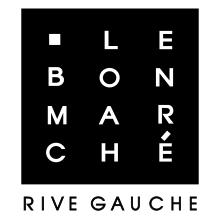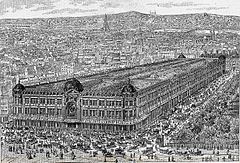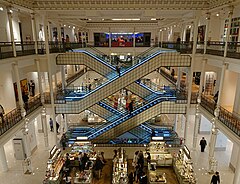Le Bon Marché
 | |
 Le Bon Marché in 2021 | |
| Company type | Subsidiary |
|---|---|
| Industry | Retail |
| Founded | 1838 in Paris, France |
| Founders |
|
Area served | Paris, France |
| Parent | LVMH (1987–present) |
| Website | www |



Le Bon Marché (lit. "the good market", or "the good deal" in French; [lə bɔ̃ maʁʃe]) is a department store in the 7th arrondissement of Paris, France. Founded in 1838 and revamped almost completely by Aristide Boucicaut in 1852, it was one of the first modern department stores. It was a member of the International Association of Department Stores from 1986 to 2011.
Now the property of LVMH, it sells a wide range of high-end goods, including food in an adjacent building at 38, rue de Sèvres, called La Grande Épicerie de Paris.
History
Early history
In 1838 Au Bon Marché was founded in Paris as a novelty shop created by brothers Paul and Justin Videau to sell lace, ribbons, sheets, mattresses, buttons, umbrellas and other assorted goods. The store originally had four departments, twelve employees and a floor space of 300 m2 (3,200 sq ft).[1][2]
Entrepreneur Aristide Boucicaut became a partner of the store in 1852, and changed the marketing plan, introducing fixed prices and guarantees that allowed exchanges and refunds, the store also now offered a wider variety of merchandise. The use of fixed prices replaced the haggling system which was then commonly used in dry goods stores.[3][4] With Boucicaut's changes the annual income of the store increased from 500,000 francs in 1852 to five million francs in 1860.[1]
In 1869 a much larger building was built for the store at 24 rue de Sèvres in Paris's Rive Gauche (Left Bank) this new building was designed by Louis-Auguste Boileau with Alexandre Laplanche ornamenting Boileau's ironwork. Louis-Charles Boileau son of Louis-Auguste Boileau also continued designing for the store in the 1870s.[5] The store was expanded again in 1872 with the help of the engineering firm of Gustave Eiffel, creator of the Eiffel Tower.[3]
By Boucicaut's death in 1877 the stores income had risen from twenty million francs in 1870 to 72 million. After his death management of the store was taken over by his wife, Marguerite Boucicaut.[citation needed]
The floor space of the store had increased from 300 m2 (3,200 sq ft) in 1838 to 55,000 m2 (590,000 sq ft) and the number of employees had risen to 1,888 by 1879.[citation needed]
Boucicaut had become famous for his marketing innovations, including a reading room where husbands could wait whilst their wives shopped; extensive newspaper advertising; entertainment for children and six million catalogs sent to customers. By 1880 half the employees of the store were women. Unmarried women employees lived in dormitories on the upper floors.[6]
In the 1920s Louis-Hippolyte Boileau grandson of the architect Louis-Auguste Boileau who had designed the store in the 1870s worked on an extension of the store.[citation needed]
On 31 August 1959 a branch store was opened in Caen. This store was later closed in 1989 and sold to Printemps.[7]
In 1974 the branch store in Metz was sold to Printemps.[8]
Under LVMH
In 1984, Bernard Arnault purchased Bon Marché and in 1987 the company became a founding member of Arnault's group LVMH.[9]
Operations
In 1922, when the decorative arts were at their high point in France, the Pomone design and decorating department was established, following the trend of other Parisian department stores. From 1923 to 1928, Paul Follot (1877–1941) was its director, followed by René-Lucien Prou (1889–1948) and Albert-Lucien Guénot (1894–1993) up to 1955. Today's home-furnishings inventory primarily consists of brand names but not white goods.
Influence
The building inspired the design of the Bon Marche store in Sydney, designed by Arthur Anderson,[10] as well as the Galerias Pacifico shopping centre in Buenos Aires, originally called Argentine Bon Marché.[11]
Zola's novel Au Bonheur des Dames was inspired by the story of Le Bon Marché.
Buildings
Le Bon Marché consists of three buildings separated by rue du Bac and rue de Babylone:
| Building | Above- ground floors |
Basement floors |
Total surface area m² |
SHON*(fr) m² |
Retail SHON* m² |
Selling floor + stock- rooms m² |
Ground m² |
|---|---|---|---|---|---|---|---|
| 24, rue de Sèvres[12] | 6 | 3 | 58,433 | 55,213 | 45,341 | 27,821 | 9,708 |
| 26-38, rue de Sèvres[13] | 6 | 2 | 30,218 | 27,328 | 13,853 | 4,372 | |
| 16, rue de Babylone | 19,819 | 2,672 | |||||
| Total | 102,360 | 16,752 |
*SHON = surface area minus that of the stairs, lifts, unusable ceiling spaces, roof terraces, open-air terraces, balconies, corridors and garages; less a further 5% for insulation.[14]
See also
References
- ^ a b Jacques Marseille. "Naissance des grands magasins : le Bon Marché" (in French). Ministry of Culture of France. Retrieved 23 October 2018.
- ^ Huon, Julie (24 September 2020). "Expo: la Belgique envahit le Marché à Paris". Le Soir (in French). Brussels. Retrieved 5 December 2024.
- ^ a b Gapper, John (27 November 2019). "LVMH has become a luxury department store". Financial Times. Archived from the original on 11 December 2022. Retrieved 29 November 2019.
- ^ Ladonne, Jennifer (December 2014 – January 2015). "Three Grandes Dames: The History of the Legendary Department Stores of Paris". France Today. Vol. 30, no. 1. pp. 70–74.
- ^ Fitoussi, Brigitte & Fortes, Imogen (2017). 50: Paris in Fifty Design Icons. London: Conran Octopus. pp. 18–19. ISBN 978-1840917420.
- ^ Jan Whitaker (2011). The World of Department Stores. New York: Vendome Press. p. 22. ISBN 978-0-86565-264-4.
- ^ Toussaint, Renaud (29 August 2015). "1959, on fait ses courses Au Bon Marché" [In 1959, we shopped at Au Bon Marché]. Ouest-France (in French). Rennes. Retrieved 5 December 2024.
- ^ "Metz. Fermeture définitive du Printemps : l'histoire de ce grand magasin en 5 dates-clés" (in French).
- ^ Song, Vivian (4 March 2020). "World's oldest department store feels like the streets of Paris". CNN. Retrieved 12 July 2023.
- ^ "You Need To See The Stunning Design Furniture Of Le Bon Marché". Paris Design Agenda. 26 September 2016. Archived from the original on 29 September 2020. Retrieved 11 July 2024.
- ^ Fodor's Argentina: with the Wine Country, Uruguay & Chilean Patagonia (8th ed.). Fodor's. 2015. p. 36. ISBN 0804142858.
- ^ PC 075.107.90.43700 dated 4 January 1991
- ^ DP 075.107.12V0080 dated 16 May 2012, later modified by PC 075.107.12.V0032 M3 dated May 2016.
- ^ "Buying a house in France: what to watch out for". www.ausud.com. Retrieved 24 November 2023.
Further reading
- Aitken, Sally (27 July 2011). "The Birth of Shopping". Seduction in the City. Season 1. Episode 1 – via IMDb.
- Byars, Mel. "Follot, Paul" "Pomone", "Guénot, Albert-Lucien", and "Prou, René-Lucien", The Design Encyclopedia, New York: The Museum of Modern Art, 2004, pp. 234, 289, 585, 598–599. ISBN 0-87070-012-X, 978-0-87070-012-5.
- Sennott, R Stephen ed., "Department Store", Encyclopedia of 20th-Century Architecture, New York: Fitzroy Dearborn, vol. 1, A–F, p. 356.
- Zola, Émile, Au Bonheur des Dames, Paris: Charpentier, 1883. First serialized in the periodical Gil Blas and then published as the 11th novel in Zola's Rougon-Macquart series. Is one of Zola's more positive novels about changes in society during the Second Empire; documents the birth of modern retailing and changes in city planning and architecture; considers feminism; deconstructs desire in the marketplace; and tells in a Cinderella format the life of the Boucicauts who, in the novel, appear as Octave Mouret and Denise Baudu.
- Michael B. Miller, The Bon Marché: Bourgeois Culture and the Department Store, 1869–1920, Princeton: Princeton University, 1981
